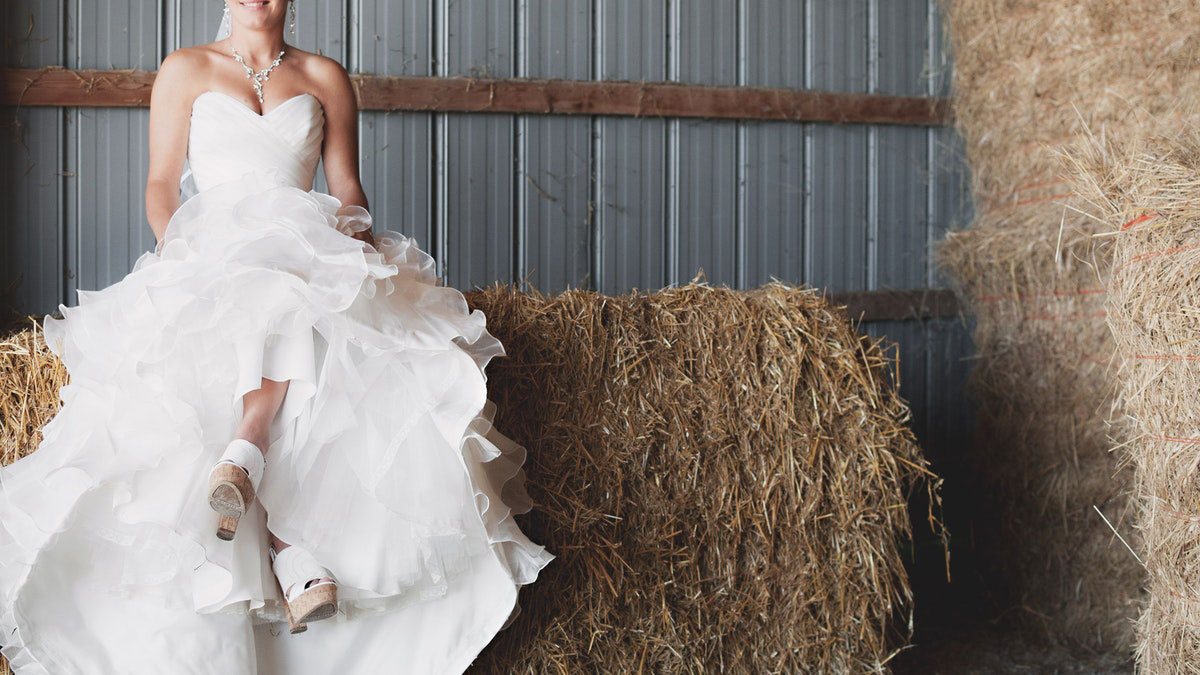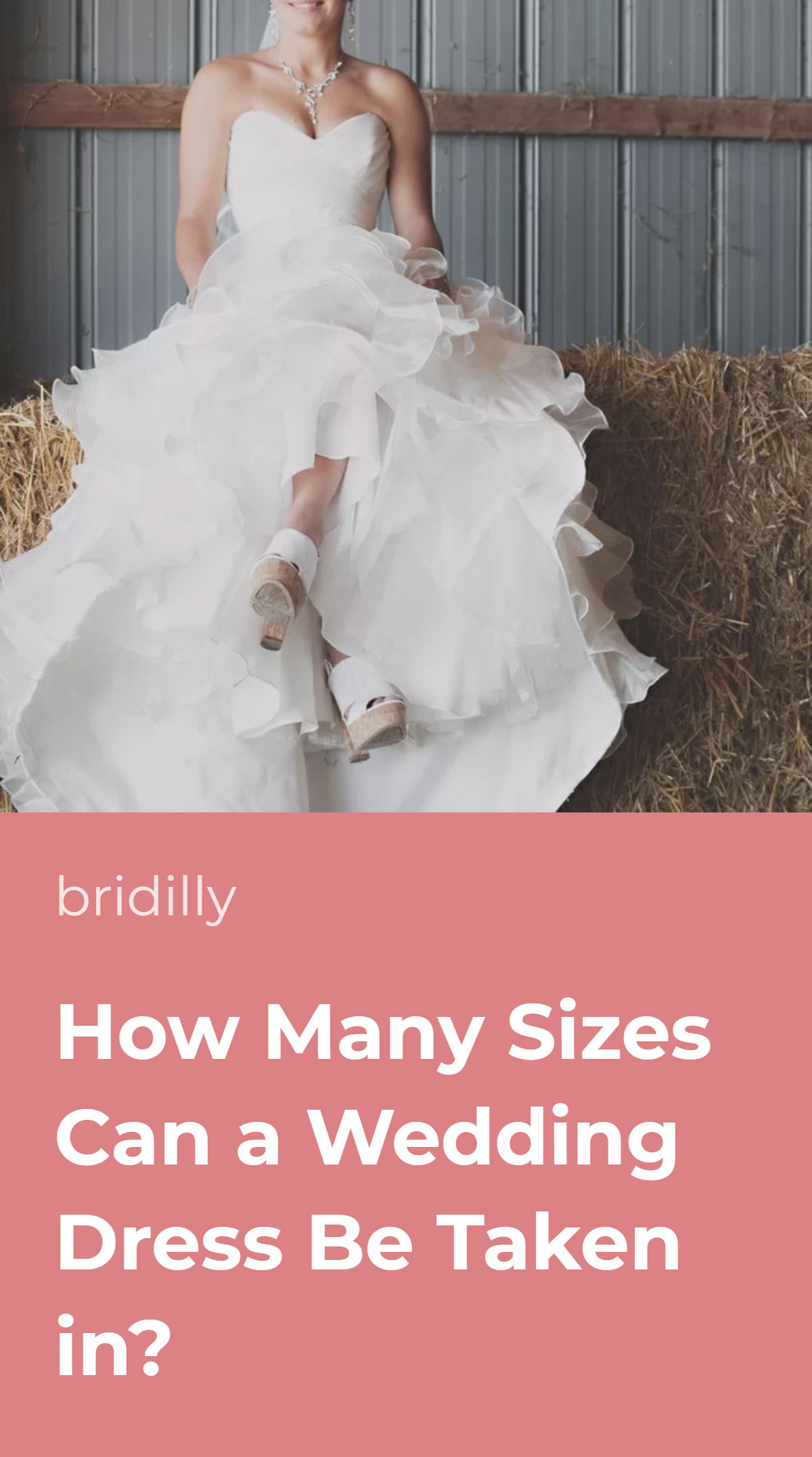If you’re looking for a clear answer to “how many sizes can a wedding dress be taken in?” you may be disappointed.
Any dress can be sized down, but the extent varies depending on numerous factors. Each case is unique.
However, you can try to determine whether your wedding dress is alteration-friendly by its design, fabric, and silhouette.
If you’re only considering buying a gown but already know it’s too large, consult with a seamstress beforehand instead of blindly trusting the bridal stylist.
Most importantly, consider the wedding dress alterations timeline and cost. Technically, any dress can be made smaller, but are you willing to invest the time and money?
Table of Contents [show]
Safe Sizing Down
Taking in a wedding dress is a standard alteration because each of us is unique, and two brides wearing the same size can have very different figures.
Furthermore, many women lose weight for their wedding and estimating the goal size can be tricky.
As a rule of thumb, you can safely go down one or two sizes. Such minor wedding dress alterations shouldn’t affect the dress construction and don’t typically take much time.
Usually, the sewist simply needs to take in the seams in the required areas.
If you need to take in the bust by size, the sewist can add bra cups instead of taking in the seams. This will eliminate the need for a bra and ensure the dress’s structural integrity remains unchanged.
Extreme Sizing Down
Of course, the closer your wedding dress is to your size, the better. However, wedding dress sizing is different from ready-wear sizing, so brides ordering their gowns online risk getting a dress that’s way too roomy or tight.
The issue may also arise when the bride loses too much weight due to all the stress involved in wedding planning or excess motivation. Either way, taking in a wedding dress by three or more sizes is extreme.
However, “extreme” doesn’t equal impossible. An experienced sewist can typically find a way to make an overly large dress fit like a glove, but significant alterations require more time and consequently are more expensive.
Furthermore, you’re risking damaging the dress’s structural integrity when going down by over two sizes. Extreme alterations may also affect the look of beadwork or appliques.
Choosing a skilled tailor is vital to ensure the correct fit of your gown. If you need to make your wedding dress multiple sizes smaller, research tailors in your area and try to find other bride reviews.
Don’t trust your gown to someone who has never worked with wedding dresses before.
Ideally, ask the bridal salon where you’ve purchased the dress about in-house alterations. In-house sewists have likely worked with your dress model before and know how to handle it.
Can Any Wedding Dress Be Taken in?
The short answer is – yes, any wedding dress can be taken in, but the extent of possible alterations varies. For instance, wedding dresses with intricately embellished corseted bodices shouldn’t be taken in by over two sizes.
Some delicate fabrics can’t be machine-sewn and need to be hand-stitched. Not every sewist has the necessary skills to make precise hand-stitching.
Consulting with a qualified sewist is always a good idea. Bridal stylists can sometimes assure brides that any changes are possible without considering the unique features of a specific gown.
Every gown has its limitations. Unfortunately, specifying the limits is impossible because each dress is unique, and sewists determine the work complexity on a case-to-case basis.
The good news is that taking in a dress is always easier than making it bigger. So, if you are choosing between a dress that’s too small and too large, take the latter and have it altered.
Factors Affecting the Alteration Complexity
Before you head to the local sewist, you may want to find out the factors affecting wedding dress alteration complexity. The labor complexity affects both the alteration timeline and cost.
The main factor that determines how difficult it is to take in a wedding dress is the silhouette. A-line style and ball gown wedding dresses typically don’t require hip alterations due to the full, flowy skirt.
Taking in the waist usually doesn’t affect the skirt’s fit, so the seamstress doesn’t have to alter the entire dress afterward.
Meanwhile, fitted silhouettes, such as mermaid and trumpet, often require overall alterations even if the gown is only loose in one area.
Of course, the design intricacy also plays a significant role. If the dress has any embellishments along the seams, the sewist will need to remove them before taking in the seams and attach them back afterward.
The same applies to lace overlay or appliques. If the lace overlay from both sides of the seam connects in one pattern, the sewist will have to put in a lot of work to match it after taking in the seams.
Corseted bodices are trickier to take in than plain fabric bodices without damaging the structure.
In extreme cases, the sewist may need to replace a lace-up corset with a zipper or buttons and remove boning, which is more labor-intensive than taking in the seams.
The fabric is the last but not least factor affecting the complexity of the alterations.
Taking in a dress from thick fabric like cotton and polyester is typically easier than a natural silk or organza dress due to its material delicacy.
Every sewing flaw will show on luxurious fabrics like charmeuse and silk, so the sewist must be extra cautious not to damage the material.
Of course, the more areas you need to alter, the more complex the work. Taking in the waist seams is pretty straightforward, but the process becomes intricate if you also need to take in the bust and hips.
Consider the Timeline
The general rule is to purchase your gown at least half a year before the big day because the wedding dress alterations timeline can be hard to predict. Even if you need to make seemingly minor changes, the alterations may take multiple months.
If your wedding is in a couple of weeks and you’ve just discovered your gown doesn’t fit, don’t panic – alterations may take a while, but not necessarily.
Taking in the seams by size on minimalistic dresses shouldn’t take more than a week, although this also depends on the sewist’s workload.
However, if you have a dress from natural silk with intricate beadwork, don’t rush the sewist to make alterations in two weeks.
On the other hand, making alterations too early also isn’t wise. If you still have over six months to go, don’t schedule your first wedding dress fitting until four months before the big day.
Four to three months is a sweet spot for alterations because the sewist has enough time to take in the seams and make any necessary adjustments, but your weight won’t change drastically.
Your wedding dress will likely need to undergo several rounds of alterations if it’s more than a size too big.
Sewists tend to be busy from April to October because of the bridal season. Even if taking in the seams takes a week, your queue may only come in a month. Thankfully, some sewists accept rush orders for an extra fee.
Alterations Cost
The timeline isn’t the only point to consider if you’re thinking of buying a wedding gown that’s too big or altering your mother’s old dress. Price can be a significant factor in decision-making. Weddings are costly events, and the budget is often tight.
Sometimes, brides purchase large gowns on sample sale, wishing to save some money. Unfortunately, the cost of necessary alterations often exceeds the savings.
The average price of wedding dress alterations ranges from $150 to $700, but this number includes dress hemming, adding bra cups, and other alterations apart from taking in or letting out the seams.
Expect to pay about $35-$90 per side to take in the dress sides. However, the price can be higher if the dress has intricate beading. An hour of beadwork costs $30 on average.
Note that taking in the sides often requires subsequent work, like altering the neckline or narrowing shoulders.
Shoulder and neckline alterations typically cost $50-$80 each and can be more expensive for dresses with a sophisticated design or construction.
If your dress is multiple sizes too large and you want to replace the corset with a zipper, budget at least $150.
Petite brides often need to make the dress smaller even when they purchase their regular size. In this case, the dress will likely also require hemming, which costs anywhere between $50 and $250.
Some bridal salons charge a flat fee for in-hose wedding dress alterations. However, they must charge above-average rates to make this business model work.
This option may be beneficial if you need to make the dress multiple sizes smaller or if the gown is delicate. But in most cases, paying by an individual invoice is better.
The cost of making a wedding dress smaller also varies by location. Brides in cities tend to pay more than brides from small towns because of the higher cost of living.

















No Comments Add one
Leave a Comment